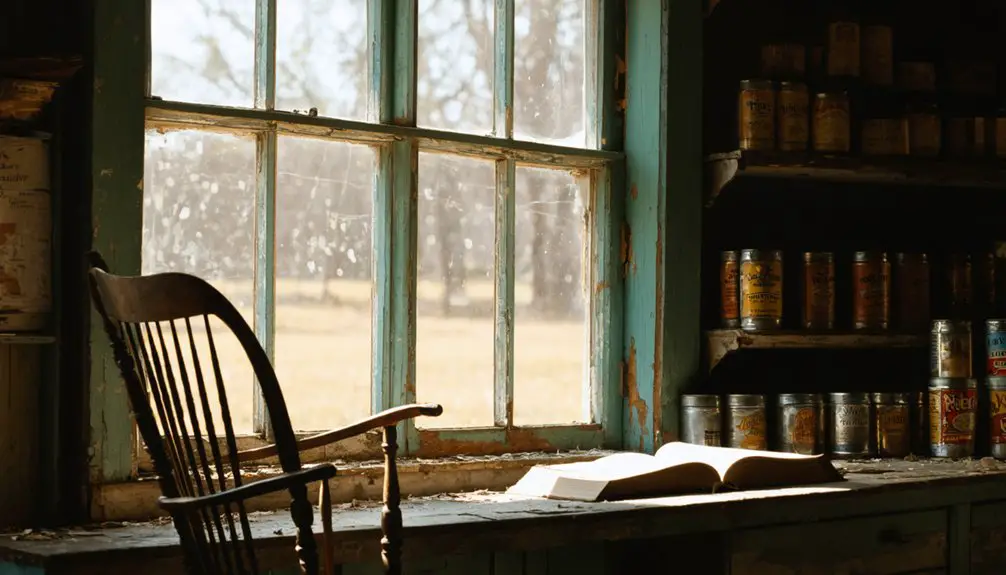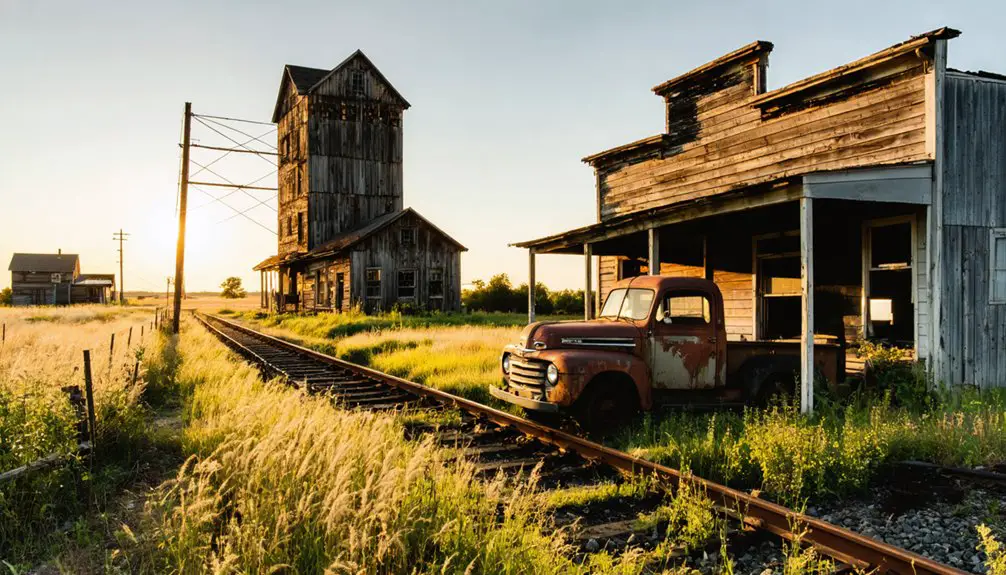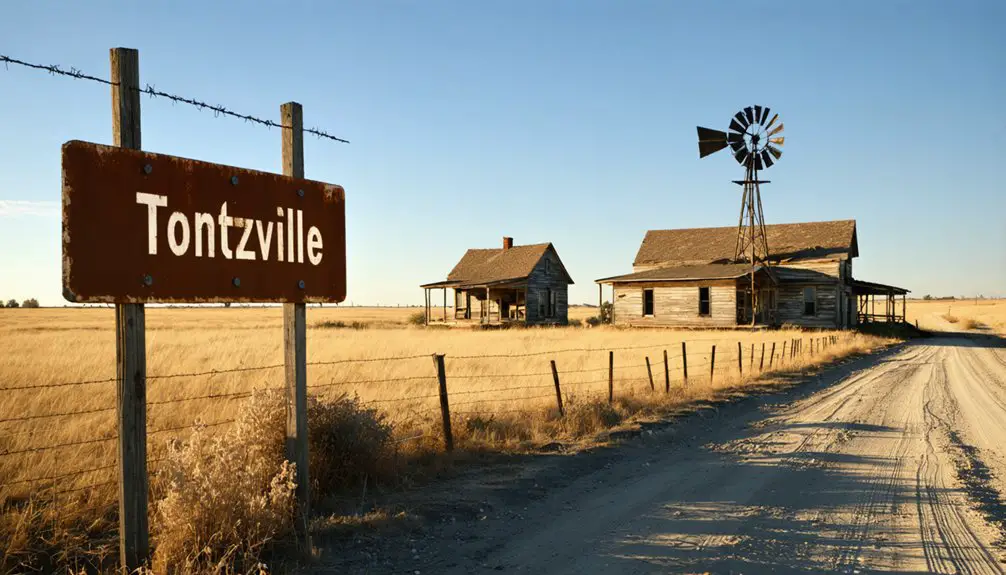You’ll find Tontzville’s remains in Clark County, Kansas, where European settlers established this agricultural hub in the 1870s. The town flourished through the Southern Kansas Railway’s cattle shipping operations and local farming until the 1920s brought devastating changes. A perfect storm of railroad service cuts, grain mill closures, and severe droughts forced the last residents to abandon their homes by 1931. The ghost town’s empty buildings and cemetery records tell a deeper story of boom-and-bust frontier life.
Key Takeaways
- Tontzville became a ghost town by 1931 after droughts, agricultural decline, and reduced railroad service forced residents to abandon their properties.
- The town’s economic foundation relied heavily on the Southern Kansas Railway for cattle shipping and agricultural transportation.
- Located in Clark County, Kansas, Tontzville was established in the 1870s and thrived briefly as a hub for mining and farming.
- Multiple environmental challenges, including the Dust Bowl and severe droughts, devastated crops and accelerated the town’s abandonment.
- The closure of grain mills in the 1920s and shifting transportation patterns toward highways eliminated crucial economic opportunities.
The Rise and Fall of Tontzville
While many Kansas towns flourished during the late 1800s, Tontzville’s story followed a familiar boom-and-bust pattern driven by mining and agricultural industries.
Similar to State Line City, which was later renamed Opolis, the town served as a vital crossroads for regional commerce.
You’ll find its community legacy traced through post office records spanning just over a decade, marking a brief period when the town served as a crucial hub for local commerce and communication.
Like many towns throughout Greenwood County’s decline from 20,000 to 6,000 residents, Tontzville’s fate was sealed by its dependence on single industries.
When mining markets shifted and new transportation routes bypassed the town in the early 1900s, you could see the writing on the wall.
The cultural memory of Tontzville lives on through cemetery records, showing how families gradually abandoned their homes in search of better opportunities.
Without economic diversification or significant political influence, the town couldn’t sustain itself as younger generations moved away.
Early Settlement and Founding Years
You’ll find Tontzville’s origins in the agricultural plains of Kansas, where settlers in the 1870s established their homesteads without the benefit of nearby rail lines that powered many other frontier towns’ growth.
Like other towns in the region, bad weather conditions contributed heavily to its eventual decline. The town’s location on farming-suitable terrain attracted primarily European-descent families who built basic structures and worked the land, though the absence of railroad connections limited its early expansion potential. Like many communities in the Great Plains states, farms struggled through devastating economic conditions during the Dust Bowl period.
As you’d expect of agricultural settlements in that era, Tontzville’s population grew modestly through family settlement rather than the rapid influx typical of mining or railroad boomtowns.
Settlement Location and Terrain
Located in the semi-arid landscape of Clark County in southwestern Kansas, Tontzville emerged during the late 19th century‘s westward expansion amid gently rolling plains and modest elevations.
You’ll find the town’s original settlement patterns reflected typical frontier development, with Sugarloaf Mountain nearby providing one of the few notable terrain features in the otherwise flat topography.
The land’s natural characteristics shaped the town’s layout, with short grass prairies and limited forested areas defining the surroundings.
While the soil proved suitable for dryland farming and ranching, sparse water sources challenged the settlers’ agricultural ambitions, much like the conditions that led to severe droughts in Irving during its early settlement years.
The remote location, distanced from major transportation routes, meant you’d have found the settlement relatively isolated, with only basic roadways and trails connecting it to neighboring communities.
The area’s terrain varies significantly, rising to 2,119 feet elevation in certain locations, as evidenced by the Mount Casino settlement site.
Railroad Development Influences
Despite the ambitious expansion of the Atchison, Topeka and Santa Fe Railway through Kansas in the 1870s, Tontzville’s founding occurred away from the main rail corridors that transformed much of the state’s landscape.
Founded as the Atchison and Topeka Railroad in 1859, the rail company would go on to reshape Kansas’s development, though Tontzville remained isolated from its influence.
You’ll find this divergence from typical settlement patterns particularly significant, as most thriving Kansas towns of that era emerged alongside railroad development.
While the ATSF was busy laying tracks and establishing depots that served as essential commercial hubs, converting millions of acres of federal land grants into construction capital, Tontzville charted a different course. By 1880, the state’s population reached one million, highlighting the transformative impact of rail connectivity on settlement growth.
Without direct rail access, the town couldn’t tap into the economic opportunities that railways brought to other communities, missing out on the important freight and passenger services that turned many Kansas settlements into prosperous market centers.
Early Population Growth Patterns
Three distinct waves of settlers shaped Tontzville’s early population growth during the post-Civil War period. You’d have seen the first pioneers arriving via wagon trains, staking their claims and establishing homesteads as the Kansas territory opened up.
The second wave brought entrepreneurs and tradespeople who’d recognized opportunities in the fledgling community, setting up essential businesses like general stores and grain operations. Like many articles about early Kansas towns, historical records required careful disambiguation of locations to accurately track settlement patterns. Following Norman traditions, many early settlers established marcher lords to protect the territory boundaries.
Settlement trends show a third influx of families drawn by the promise of newly established community services – the post office, schools, and churches.
Population demographics shifted rapidly as Tontzville transformed from scattered homesteads into an organized town. Like nearby Mortimer, you’d have witnessed quick development of local infrastructure and commerce, with new residents arriving weekly to build their dreams on the Kansas prairie.
Economic Drivers and Local Industries
As railroads pushed through Kansas in the late 1800s, Tontzville’s economic foundation emerged from the Southern Kansas Railway‘s strategic placement of track and infrastructure.
You’d find the railway’s influence extended to nearby Honeywell, where cattle shipping reached impressive volumes – with 500 loads moving through in 1889 alone. The railway attracted investors, ranchers, and workers who built hotels and commercial structures during the boom years.
The town’s agricultural viability depended heavily on the railroad’s presence, with farming and ranching serving as the economic backbone.
While mining operations in surrounding regions provided temporary boosts through lead, zinc, and coal extraction, Tontzville’s fortunes remained tied to its rail connection.
When transportation patterns shifted toward highways and automobiles, the town’s rail-dependent economy struggled to adapt.
Daily Life in Early Tontzville

Life in early Tontzville revolved around the rhythms of rural Kansas existence, where railroad schedules met agricultural demands.
You’d start your day before sunrise, tending to livestock and farm chores while the morning dew still clung to the wheat fields. Your wooden frame house, heated by coal or wood stoves, offered basic shelter from the harsh elements.
Community gatherings at the local church and schoolhouse broke up the monotony of daily routines. You’d join your neighbors for harvest festivals and church socials, strengthening the bonds that helped everyone survive.
Your children would attend the one-room schoolhouse, learning their letters alongside practical skills. When illness struck, you’d rely on home remedies until a traveling doctor made their rounds.
Life wasn’t easy, but self-sufficiency and neighborly support kept the community going.
Factors Leading to Abandonment
You’ll find that Tontzville’s decline began when several local grain mills shuttered operations in the early 1920s, eliminating the town’s primary economic engine.
The Chicago, Burlington, and Quincy Railroad‘s decision to reduce service to the area in 1924 further isolated the community, cutting off essential transportation links for remaining businesses.
A series of devastating droughts throughout the late 1920s dealt the final blow to Tontzville’s farming families, forcing most residents to abandon their properties by 1931.
Economic Base Collapse
The economic foundation of Tontzville began crumbling in the early 20th century when agricultural mechanization drastically reduced the need for farm labor.
Like many Kansas towns, Tontzville’s economic vulnerability stemmed from its heavy reliance on farming, leading to severe population dynamics shifts as younger generations sought opportunities elsewhere.
- New machinery allowed fewer farmers to work larger plots of land
- Family farms consolidated into bigger operations, reducing local employment
- Local businesses lost their customer base as farm families moved away
- Essential services like schools and medical care became unsustainable
- The town couldn’t attract new industries to replace lost agricultural jobs
Without economic diversification, you’ll find that Tontzville followed a familiar pattern seen across Kansas – as its agricultural base eroded, the town’s remaining residents gradually departed, leaving behind empty buildings and abandoned dreams.
Railroad Service Decline
While Tontzville’s agricultural decline dealt the first blow to its survival, railroad service deterioration in the 1920s accelerated the town’s demise.
You’d have seen fewer trains stopping as larger rail companies consolidated their operations along more profitable main lines, bypassing smaller settlements like Tontzville. Track maintenance became sporadic, leading to frequent service interruptions that frustrated both farmers and merchants trying to ship goods.
The light iron rails, installed during the early railroad era, deteriorated under harsh Kansas weather, making repairs increasingly costly. With dwindling passenger and freight traffic, railroad companies couldn’t justify maintaining the branch line.
Environmental Hardship Impact
As devastating as the railroad’s decline proved to be, environmental hardships struck even deeper blows to Tontzville’s survival between 1920-1940.
The town’s community resilience was tested by a relentless series of environmental challenges that ultimately proved too severe to overcome.
- Severe droughts devastated local crops and depleted groundwater resources, making farming increasingly difficult.
- The Dust Bowl of the 1930s caused widespread soil degradation, forcing many farmers to abandon their lands.
- Powerful tornadoes repeatedly damaged essential community structures, depleting limited repair resources.
- Flooding from nearby rivers damaged vital infrastructure and deterred new settlement.
- Soil erosion from deforestation and over-farming reduced agricultural productivity to unsustainable levels.
These compounding environmental pressures ultimately forced many residents to seek opportunities elsewhere, accelerating Tontzville’s decline toward ghost town status.
Structural Remains and Present Condition
Located in rural Kansas, Tontzville’s structural remains offer limited physical evidence of its former existence as a functioning community.
You’ll find deteriorating structures that have succumbed to years of abandonment, with most buildings having lost their structural integrity due to lack of maintenance and harsh weather conditions. While preservation efforts could help save what’s left, the town faces typical ghost town challenges, including limited resources and declining local support.
If you visit Tontzville today, you’ll encounter overgrown roads, abandoned buildings, and undeveloped land that’s gradually returning to its natural state.
The remaining infrastructure, likely including former homes and public facilities, continues to decay. Like many Kansas ghost towns, Tontzville’s isolation and economic decline have accelerated its structural deterioration, leaving behind a sparse reflection of its past.
Historical Significance in Kansas Ghost Towns

Throughout the late 19th and early 20th centuries, Tontzville emerged alongside thousands of other Kansas settlements during the state’s railroad expansion era.
Like many ghost towns, it represents an essential piece of Kansas’s cultural heritage, telling the story of frontier development and westward expansion.
When you explore Kansas ghost towns, you’ll discover:
- The significant role of railroad connections in determining a town’s survival
- How economic shifts and resource depletion led to community decline
- The impact of political decisions on settlement patterns
- The connection to broader narratives of Native American displacement
- The emergence of ghost town tourism as a way to preserve local history
Today, Tontzville stands as one of over 6,000 documented ghost towns in Kansas, reminding you of the state’s dynamic past and the transient nature of frontier settlements.
Frequently Asked Questions
Are There Any Known Burial Sites or Cemeteries Near Tontzville?
One of Kansas’s oldest church properties contains a documented cemetery from 1947. You’ll find burial sites at Tontzville’s church grounds, though there aren’t detailed public records of who’s interred there.
What Natural Disasters, if Any, Affected Tontzville During Its Existence?
You’ll find records showing major flood events likely impacted the town through the Big Blue River system, while drought impacts during the 1930s Dust Bowl would’ve strained local farming operations.
Did Any Notable Crimes or Lawlessness Occur in Tontzville?
You’d have witnessed a wild-west show in lawless Tontzville, where no police kept the peace. Bars and brothels ran unchecked, though specific crimes weren’t documented in this rough mining town.
Were There Any Native American Settlements in the Tontzville Area?
You’ll find that Kansa Native American settlements existed near Tontzville, with their prominent Blue Earth Village just miles away housing 1,200-1,900 people in 160 earth lodges during the 1800s.
What Transportation Routes Connected Tontzville to Neighboring Towns?
Like spokes on a wagon wheel, you’d find dirt roads branching out from Tontzville connecting to stagecoach stops, though it never got direct railroad connections or major highway routes during its heyday.
References
- https://www.geotab.com/ghost-towns/
- https://www.youtube.com/watch?v=alC1wDdSVvg
- https://www.onlyinyourstate.com/trip-ideas/kansas/diamond-springs-kansas
- https://www.youtube.com/watch?v=OyBXD18P_j4
- https://en.wikipedia.org/wiki/List_of_ghost_towns_in_Kansas
- https://www.youtube.com/watch?v=5UTFd2JlelY
- https://www.kcur.org/arts-life/2022-04-09/ghost-towns-are-all-around-kansas-city-if-you-know-where-to-look
- https://thewanderingpigeon.com/2015/10/03/day-of-kansas-ghost-towns/
- https://www.hhhistory.com/2019/05/ghost-towns-of-kansas.html
- https://www.sumnernewscow.com/four-sumner-county-ghost-towns-will-be-featured-on-pbs-documentary-tonight/



